Manitoba Insect & Disease Update: June 16, 2015
Summary
Scout cereal crops for rusts, and consider whether fusarium is a risk. Insect feeding has been minimal in cereals, however watch for signs of feeding or larvae of cereal leaf beetle so we can assess levels of parasitism if these are present.
In canola, flea beetles are still present at potentially damaging numbers for fields that may not have 3 or 4 true leaves yet.
In forage crops, alfalfa weevil is at high levels in some alfalfa fields in the Interlake and Dauphin area.
Cutworms continue to be of concern in some fields. In cooler springs cutworms can continue to be a concern into late June. Consider the size of larvae when making control decisions. If there are a lot of larvae under 2.5 cm, then there is still the potential for considerably more feeding damage. If the majority of larvae are over 2.5 cm, feeding will be ending soon.
Cereal Crops
Stripe Rust: The first report of stripe rust in Manitoba has come in from a winter wheat field southwest of Killarney (Fig. 1). Stripe rust and cereal leaf rust were also observed at extremely low severity in the MCVET winter wheat plots in Carman. Previous reports from North Dakota indicated that this disease was present all the way up to the Canadian border. Many winter wheat fields in the province are reaching the early flowering stage which is the key timing for a fungicide application to manage Fusarium head blight. A fungicide at this timing will also help protect the flag leaf from leaf diseases such as stripe rust. Continue to scout both winter and spring cereal crops for rusts and report any finds to MAFRD so that the locations of these diseases can be shared with others.
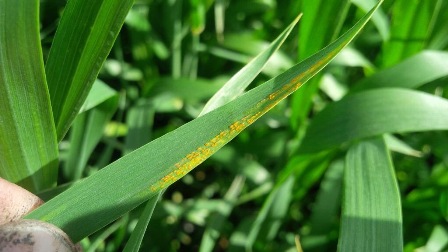
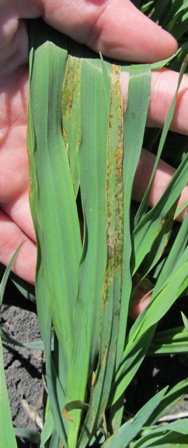
Fig. 1. Stripe rust. Fig. 2. Bacterial blight.
Photo courtesy of Paterson Grain Killarney (Crop Inputs)
Bacterial Blight: There have been unconfirmed reports of bacterial blight in oats in the province. This is not an uncommon issue in oats especially when the weather is cool and wet. Symptoms of bacterial blight in oats often start out as water-soaked lesions on the leaves (Fig. 2) that later turn necrotic. Typically good growing conditions allow the crop to grow through this issue without any long-lasting effects. Proper diagnosis of the disease is key to prevent any unwarranted fungicide applications.
Cereal leaf beetles: Cereal leaf beetle is a newer insect in Manitoba, first found in Manitoba in 2009. They feed on grassy plants, including cereal crops and forage grasses. There is a species of parasitic wasp, called Tetrastichus julis, that is extremely effective at locating and parasitizing cereal leaf beetle larvae. These wasps specifically parasitize cereal leaf beetles, and where populations of the wasps establish cereal leaf beetles usually remain at low levels.
Larvae of cereal leaf beetles are beginning to emerge. If you notice cereal leaf beetle larvae in your cereal fields, it would be good if we knew if any of these larvae are parasitized. This way we can determine which regions in Manitoba already have the parasitoid, and which regions are higher priorities for doing additional releases. A project is being conducted again this year, in co-operation with entomologists at Agriculture and Agri-Food Canada in Lethbridge, Alberta, to dissect samples of larvae of cereal leaf beetle to determine levels of parasitism, and release parasitoids to regions where cereal leaf beetle is present but the wasps are not. Those submitting samples will be informed of the parasitoid status of larvae form their field, and where needed releases of parasitoids can be co-ordinated.
So if you do notice cereal leaf beetle larvae in fields you are in, consider collecting a sample and sending them in to be checked for level of parasitism. Larvae may be more abundant in areas where the crop is more vigorous. Ideally collect at least 30 larvae, either by visually inspecting for them and collecting off plants, or using a sweep net to collect them. Place them in a container with some food. Samples can be sent to:
Dr. Hector Carcamo, Entomologist
Agriculture and Agri-Food Canada
5403 - 1 Ave S., Lethbridge, Alberta, T1J 4B1
Agriculture and Agri-Food Canada
5403 - 1 Ave S., Lethbridge, Alberta, T1J 4B1
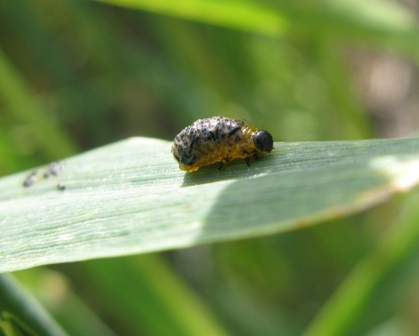
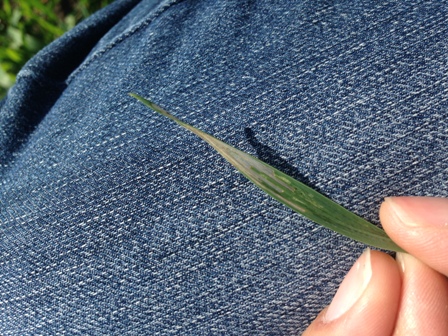
Fig. 3. Larva of cereal leaf beetle. Fig. 4. Feeding by larvae of cereal leaf beetle.
Photo from Amber Knaggs - Munro Farm Supplies Ltd.
The feeding by the larvae may initially draw your attention to plants where cereal leaf beetle are present. Larvae feed on the tissue between the veins on the upper leaf surface, leaving the lower epidermal cuticle intact. So you may see a window effect on the leaf (Figure 4). Larvae are small, and may appear oily. They may be coated in fecal material, which is thought to protect the larvae from predation and desiccation, but it also appears to attract some of it’s host-specific parasites.
Forage Crops
Alfalfa weevil: High levels of alfalfa weevil have been reported in some fields of alfalfa in the Interlake region and near Dauphin, with some insecticide applications occurring.
In hay crops, one of the best control strategies is to cut the alfalfa early, which will result in larvae starving or desiccating. It is safe for livestock to consume alfalfa weevil larvae in feed. In seed crops early cutting is not an option. If using an insecticide, do check to ensure that you got good control. Some insecticides are registered as "suppression" or "reduction" only of alfalfa weevil. And if using a pyrethroid insecticide (Decis, Matador, Silencer) make sure not to apply these when temperatures get too hot.
Note that the first 2 stages of alfalfa weevil are a light yellow or tan colour. They are also quite small, with the first instar larvae being about 1 mm long. The third and fourth stages of larvae are bright green with a white stripe down the centre of the back and a black head capsule. They only grow to about 8 or 9 mm long.
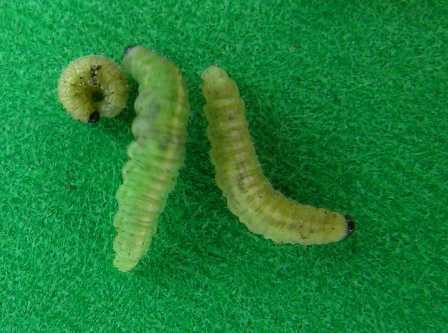
Fig. 5. Larvae of alfalfa weevil.
Insect Monitoring Programs
Diamondback Moth: The following are the highest cumulative counts for the traps for adult diamondback moth in Manitoba from April 26 to June 16, 2015.
| Nearest Town | GO Team | Cumulative Trap Count |
|---|---|---|
| Portage la Prairie | Central Plains | 156 |
| The Pas | Valleys North | 152 |
| Kane | Red River | 152 |
| Morris | Red River | 147 |
| Faulkner | North Interlake | 134 |
| Swan River | Valleys North | 102 |
| Rosenort | Red River | 90 |
| Ste. Elisabeth | Red River | 79 |
| The Pas | Valleys North | 77 |
| Steinbach | Eastman | 77 |
Numbers overall are not very high, but some moths have arrived. How economical this is likely to become is hard to say and depends on many factors, including weather and natural enemies that may either overwinter in Manitoba or potentially move in on the same winds as diamondback moth. Look for signs of feeding and larvae of diamondback moth during regular field scouting. So far only low levels of larvae of diamondback moth have been found.
Bertha armyworm: Moths of bertha armyworm are just starting to emerge. Most traps have not recorded any yet; a few traps have caught very low levels (less than 4).
The photo below is of moths of bertha armyworm. Note that moths other than bertha armyworm sometimes do end up in the traps. Moths of bertha armyworm will have irregular transverse white markings near the tip of the forewings, and above these markings there are white, kidney-shaped markings towards the wing margins.
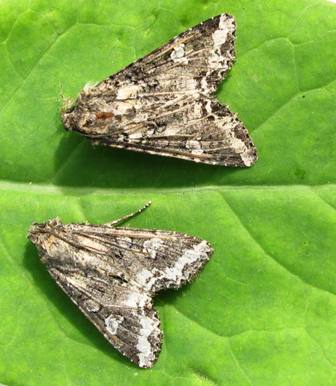
Fig. 6. Moths of bertha armyworm
Compiled by:
•John Gavloski, Entomologist
Manitoba Agriculture, Food and Rural Development
Phone: (204) 745-5668
Fax: (204) 745-5690.
•Holly Derksen, Plant Pathologist
Manitoba Agriculture, Food and Rural Development
Phone: (204) 750-4248
Fax: (204) 745-5690
To report observations on insects or plant pathogens that may be of interest or importance to farmers and agronomists in Manitoba, please send messages to the above contact address.
To be placed on an E-mail list so you will be notified immediately when new Manitoba Insect and Disease Updates are posted, please contact John Gavloski at the address or numbers listed above.
Manitoba Insect & Disease Update: June 16, 2015

